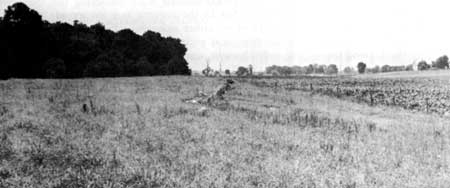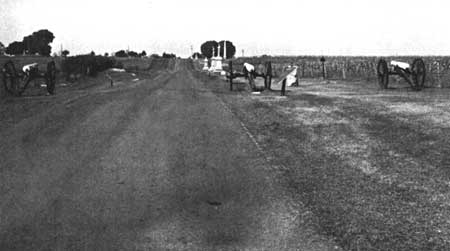|
ANTIETAM National Military Site |
 |

East Woods on left: Miller cornfield, where Lawton's men were hidden,
on right. This view looking south, as Hooker's men saw it at dawn.
Hooker Strikes at Daybreak
A drizzling rain fell during the night. The morning of the 17th broke gray and misty, but the skies cleared early. As rays of light outlined the fringe of trees about the Dunkard Church, restless Federal skirmishers opened fire. A line of rifle fire flashed from the Southern muskets far out in front of the church. Soon, powerful Federal guns on the bluffs beyond Antietam Creek poured a raking fire of shot and shell into the Confederate lines. The first stage of McClellan's plan of crushing Lee—folding up the Confederate left flank—was about to begin.
Hooker struck with tremendous force. With skirmishers still hotly engaged, 10 brigades moved out from the cover of the North Woods. Brig. Gen. Abner Doubleday's men advanced along the Hagerstown Pike. Brig. Gen. James Ricketts' force charged down the Smoketown road toward the Dunkard Church. Part of Meade's division in the center was held in reserve. Hooker's artillery, massed on the ridge near the Poffenberger house, raked the Confederate lines. Heads down and bent to the side, like people breasting a hailstorm, the wave of Federals charged southward, spreading over the front from East Woods to the fringe of West Woods.
From left and from right, Confederate brigades poured into the fray to buttress Jackson's line of battle. D. H. Hill sent three brigades from the Sunken Road, dangerously weakening his own line—but then, first things first, and this is the story of the Confederate defense throughout the day. Hood's two brigades stood in reserve in the woods adjoining the Dunkard Church. Eight thousand Confederates awaited Hooker's assault.

View from the south, as Jackson's men saw it. Cornfield ahead;
East Woods at right.
While most of Jackson's men formed a line from east to west in front of the Dunkard Church, Brig. Gen. A. R. Lawton had sent a strong force into the Miller cornfield, 300 yards in advance concealed, he believed, from the enemy.
Doubleday's Federals came upon the cornfield. "As we appeared at the edge of the corn," related Maj. Rufus Dawes, "a long line of men in butternut and gray rose up from the ground. Simultaneously, the hostile battle lines opened a tremendous fire upon each other. Men, I cannot say fell; they were knocked out of the ranks by dozens." Hooker, nearby, saw farther in the field the reflection of sunlight from the enemy's bayonets projecting above the corn. Ordering all of his spare batteries to the left of this field, the Federal guns at close range raked the cornfield with canister and shell. "In the time I am writing," Hooker later wrote, "every stalk of corn in the northern and greater part of the field was cut as closely as could have been done with a knife, and the slain lay in rows precisely as they had stood in their ranks a few moments before. It was never my fortune to witness a more bloody, dismal battlefield."
Those Confederates who survived the slaughter in the cornfield now fled before the Federal onslaught. Heading for West Woods, they had to clamber over the picket-and-rail fence bordering the Hagerstown Pike; many were shot in the attempt and lay spread eagled across the fence or piled on either side.
One soldier recalled the hysterical excitement that now gripped the Union troops: The only thought was victory. Without regard for safety, they charged forward, loading, firing, and shouting as they advanced. In contrast were the fallen—as waves of blue-clad troops swept by, wounded men looked up and cried for aid, but there was no time to stop.
While Doubleday's division charged through the cornfield, Rickett's men, on the left of the attacking columns, pushed through the East Woods to its southern fringe. Capt. Dunbar Ransom's battery broke from the cover of the East Woods and fired shot and shell into the staggering Confederate lines.
For more than an hour, the battlefront flamed along an extended semicircular line from the open fields of the Mumma farm northwest through the cornfield to the rocky ledges in West Woods. The fury of the Federal attack had carried Doubleday's and Ricketts' men deep into the Confederate line, and now Meade's reserve brigades rushed forward.
In this critical stage, Jackson launched a driving counterattack. Hood's men, supported by D. H. Hill's brigades, battered the Federals back to the cornfield but were halted by the pointblank fire of Union guns in East Woods.

Cornfield Avenue, marking southern limit of "bloody cornfield." Federals
charged from right; Confederates counterattacked from left. From
photograph taken on anniversary of battle, showing corn as it stood
when the fighting began.

|

|
|
Last Modified: Mon, Mar 4 2002 10:00:00 pm PDT |


